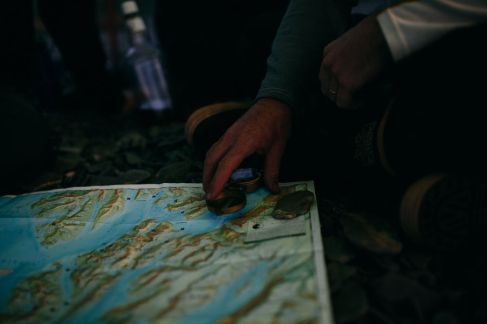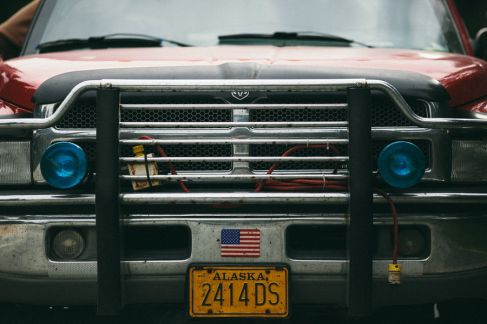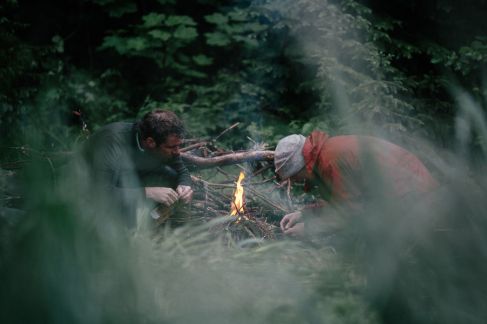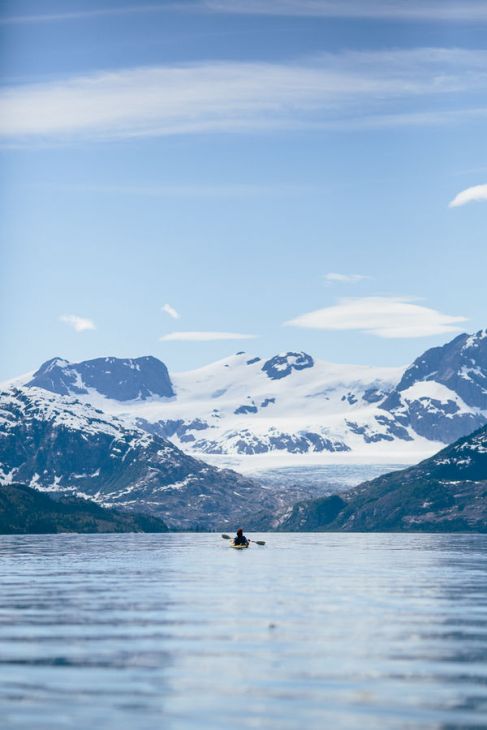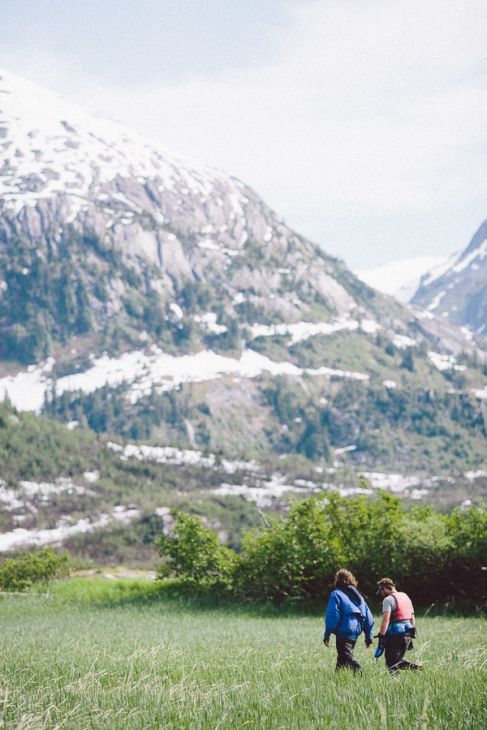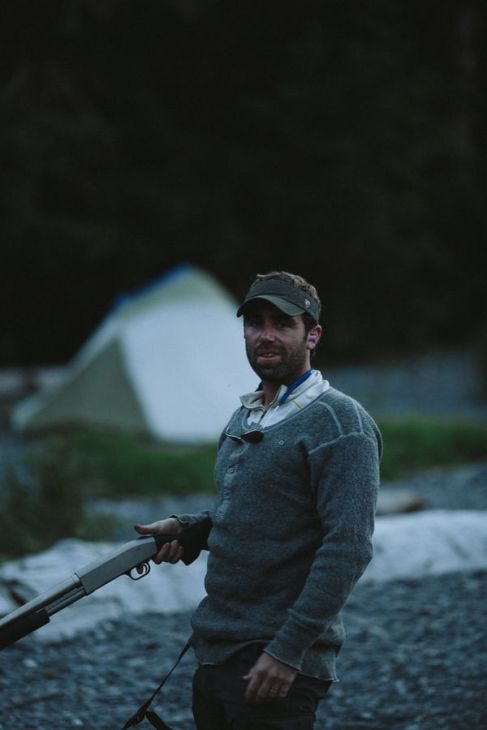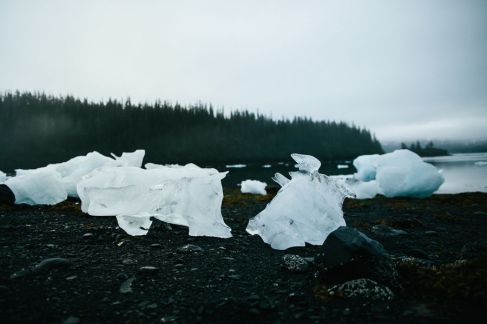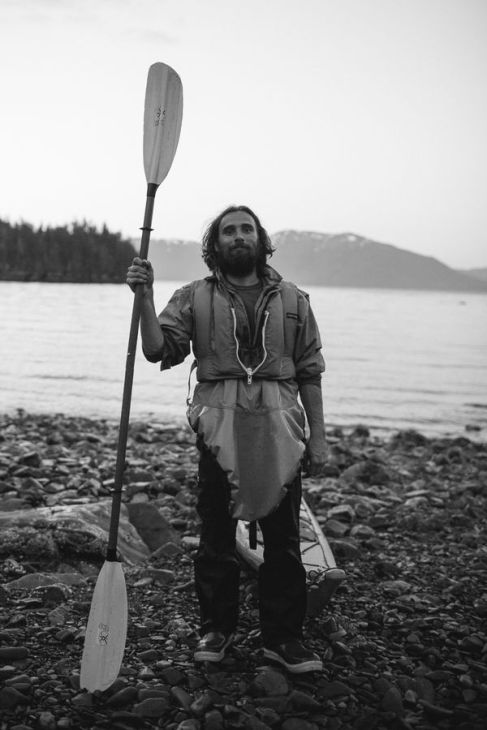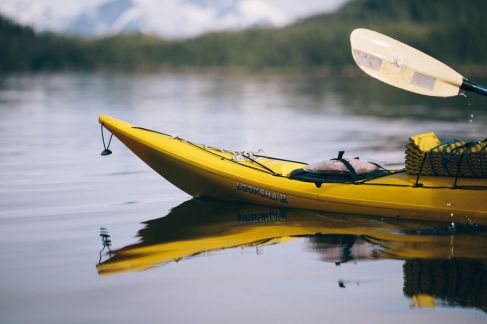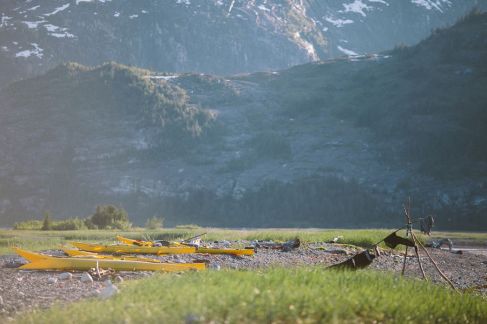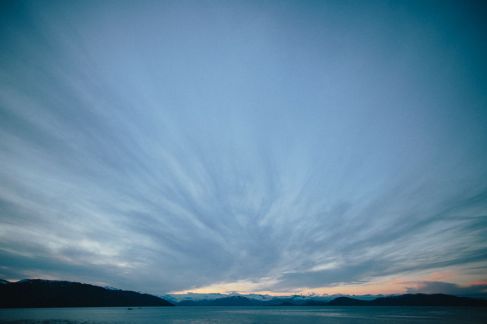Freedoms and Fears: Kayaking on Prince William Sound
“Kayak” is an Inuit word meaning “man’s boat,” and there is no better description of our vessels by the end of the journey. Our decks were covered in fish blood (a messy indication of success), and our hatches were filled with empty whiskey bottles and spent shotgun shells. Our “man fleet” was coated with heavy barnacles of sea stink no sweet cedar breeze could mask. It was verified upon reentry to the town of Whittier that we carried a noble stench, even by Alaskan fishermen standards.
Considering the kayak was first imagined and floated in the waters of Alaska, it is an appropriate place to paddle. Our team’s plastic crafts were far different than early native models, but some of our intentions remained the same—explore swaths of Prince William Sound, admire the monotony of natural beauty, fish the stockpiles of salmon.
I landed in Anchorage on July 3rd for the nine-day paddle with old friends. The flight north is an experience in itself. At thirty-thousand feet, the shrouded, northern grip of Alaska reveals little but white and blue, mountains and water. The brawny Wrangell-St. Elias peaks breach the foggy inside passage and salute every oiler, angler and continental fugitive on board. Tucked below the granite and snow-dusted crown lies a wilderness miracle itching to be unfurled. Everything appears more serene, however, than reality dictates. Welcome to Alaska: the summer’s host, and winter’s hostage.
At the airport I waded through the thick of camouflage and flannel. Sportsmen arrive here with duffel bags of ammunition and tackle, and depart with trophies and game.
After collecting my baggage and fellow paddlers, we hopped in my friend’s truck and drove straight through the city. Despite holding half of Alaska’s population, Anchorage still feels like a trading post en route to a further destination. There are plenty of liquor stores and gun shops available to enjoy your layover. One storefront had a notice on the door: “We don’t know when more ammo will arrive. No, Obama did not steal your ammo.”
Once you clear the city, it doesn’t take long to appreciate the frontier landscape. The scale is enormous. All natural features are magnified by vertical relief and open distance. Clear days allow for epic vistas. We drove east, between the tidal giant of the Cook Islet mud flats and the Chugach mountains. The road was littered with signage from the Department of Transportation’s “Scenic byway” labeling campaign. To designate any one spot a “viewing area” in a land so impressive is comical.
Through a rough, single-lane tunnel lies Prince William Sound. The large seaway is home to a dozen quiet towns, but none like Whittier, a deep-water fishing hamlet with a terribly wet microclimate. Surrounding communities like to say, “It’s always shittier in Whittier.” This clever snub is not limited to the weather. In addition to the fishing game, it serves as a seasonal spilling-ground for tourists. Cruise line flotillas empty their holds in Whittier, and those willing to leave the leeside vodka bar take shore leave, leaving trodden trails of broken English and international currencies. Albeit, with the best clam chowder on the planet, a few watering holes, and locals selling musk ox slippers, Whittier has something for everyone.
This was the departure point for our group. With a curt orientation and final instructions on where to avoid “bug and bear infested hell,” we were quickly outfitted and ferried two hours from port to the aptly named Icy Bay. Between diminishing icebergs and restless humpbacks, 200 miles from a hamburger, we took stock of our environment.
The plan was to travel 120 miles over nine days. None of us had spent much time in a sea kayak, but our inexperience was not considered a hindrance. It was curiously assumed that if we read the tidal charts correctly, we would be carried from camp to camp with manageable shoulder and back strain. Of course, within a few hours of paddling I quietly began scheduling trips to a chiropractor and a rotator cuff specialist. It was a great blessing that our first aid kit included aspirin, Tylenol, ibuprofen, Aleve, Vicodin—everything short of morphine, which is no longer considered a performance-enhancing drug.
The remainder of our medical supplies were decimated by our friend Adam, who lost a few pints of blood, and a good portion of his left thumb, dicing onions with a 15-inch hunting knife.
It rained lightly in Whittier, and the further we motored out of radio contact, it fell progressively heavier. We were exposed in the northern reaches of the largest temperate rainforest on Earth. Foul weather was likely to test our gear and preparedness. And it did. Two days and six inches of rain into the trip, everything was wet, and the temperature was falling.
The first degree of saturation was a thick film of perspiration generated soon after paddling. This was intensified by waterproof clothing, and the sweats trickled like a leaky cistern. Once the base layers were damp, and the rain came pounding down, our good fortune vanished. It was no relief to be surrounded by ice water, puddles forming on every collection point. Jackets became laughably drenched, woeful protests turned silent, and morale morphed into a regretful oblivion. We sulked about camp, and our whiskey stash was quickly rationed in good maritime fashion.
At first glance, Alaska is a suitable habitat exclusively for marine mammals. Ancestors of the area were forced to fashion their clothes from these animals to survive. A sea lion slicker may be overkill in the summer, but with our raincoats defeated, all options were on the table.
A break in the clouds reminded us why we endured the dark limbo. Sunshine is always the difference between a summer celebration and a cold slog through a non-refundable holiday. Even so, a bluebird day on Prince William Sound is a lot to ask for. Alaska’s harsh weather is the reason this great state is so sparsely developed. The bare, white wind has about the same hard attraction as a Russian lover, though slightly more intimidating.
Our route took us through opened fjords and beached us on the edge of wind-blown hemlock and spruce forest. The elements have stunted many of the trees to bonsai stature, but the bush remains deceivingly thick. Though we nixed an early plan to portage our boats from one bay to another, we were able to explore the inner headlands. Behind the overgrown skunk cabbage and devil’s club was a Disney-inspired mossy lair—dripping curtains of green lichen furnished the canopy like balls of cotton candy. Every fallen tree and stump was a softened throne of moss for resident porcupines and the occasional brooding bear.
My fear of bears was hardly quelled with another trip to Alaska. The bears in the region were not the kind that dance and ride bicycles, domesticated by communist carnies. They were our fishing competitors, and with all the salmon we had been handling, we might as well have been wearing sashimi outerwear. Thankfully, we were armed with a pump-action shotgun. With the Grizzly Persuader locked and cocked, the old adage “If it’s brown, lay down, if it’s black, fight back” no longer applied.
From the beginning, the nuisance of bears was eclipsed by a punishing typhoon of bugs. Mosquitoes greeted us a hundred yards from shore, making it clear we would be spending the night together. Bug repellent, to an Alaskan sand fly, must be an inviting fragrance akin to a jelly donut. Donning haloes of insects, we defended ourselves with beards, bandanas and headnets—the nets like thin black veils with us grieving the loss of a bugless state. In the evenings, I stood close enough to campfires to incinerate all pests and melt half of my wardrobe.
Alaska is a strong, blended daiquiri of misery and beauty. It is a challenge to simply visit, and I cannot imagine enduring this spectacular suffering full-time. The organizer of our trip, Gregor, is an old friend who now lives just outside of Anchorage. He is a glass half-full (of liquor) kind of man, who focuses on being protected geographically and not trapped meteorologically. When I suggested only a southern sadist would move up here, Gregor replied, “It’s better than living in Ohio.” It’s difficult to refute that statement in any context.
Gregor moved to the area years ago and works a tree service, sawing himself into a seasonal frenzy. A raised chainsaw scar on his neck was a good indication of his resolve to show us a wild time, and hopefully avoid decapitation. He was a tremendous local guide, fraught with practical knowledge. His ability to start a fire in monsoon conditions was close to sorcery. With a Japanese handsaw on his hip, he sliced through layers of dripping foliage, collected suitable wood, and seemingly conjured fire from water.
Alaskan transplants like Gregor have become a hardy hybrid of North American. They shuffle along with a Canadian pace and sensibility while showcasing rugged American independence. No other countrymen embrace the wild spirit of the nation like Alaskans. It was the second to last state invited to the party, and it remains the last bastion of primitive America.
A short stay in the Alaskan bush is not going to reverse a lifetime of coddling, but the wilderness took us to the brink. A famous naturalist once said to beware of anything that requires new clothes. My rubber boots were a perfect example of what Thoreau meant. We were pleased to purge our city smog, but packed a few comfort items for good measure. We enjoyed chocolate pudding, bottles of kimchi, and a Chinese wok, among other absurdities. We probably would have packed exotic concubines had our kayaks afforded such luxury.
The rest of our inventory was even more questionable. It was a mistake to leave our meal itinerary to our friend enchanted with Indian food. It did not occur to JC that hot links and curry may upset a fragile intestinal balance, at sea no less. There were several occasions of making haste for a shoreline latrine.
Nonetheless, after a few tough days any food was good food. I would have settled for a handful of anti-inflammatories and a warm cocoon. I was so worn each night, I slept deep as if swaddled by a local Goddess. They say that which feeds you will one day swallow back.
Before the trip, everybody told me to exercise caution. When people tell you to “be careful,” they are suggesting you are ill-prepared, or moving beyond your capabilities. We were not out to prove anything, it just requires a close encounter with a foreign place to understand it. This trip had its risks. A prolonged dip in 40 degree water produces rapid hypothermia. Being out of radio contact meant there was no room for error.
We had no trouble in the end, though we paddled through unusual conditions. To view the mighty Chenega glacier, we were funneled into a swirling bay, choked up with icebergs, flipping without warning. Glacial winds pounded the water, daring us to approach. We struggled to chunk our way through the labyrinth toward the white wall. Our yellow kayaks, bashing through ice packs, were like taxi cabs plowing through an East coast snowstorm. Each time the glacier calved it sent massive daggers into the bay, releasing a sizeable wake to paddle through. The water breathed with each frozen avalanche. The ice wall groaned, lamenting the constant splintering of its mass. Rain clouds and fog pressed down with cold gravity and we navigated the changing dynamics of the bay—the ice circled counterclockwise in an unpredictable origami. Curious harbor seals, spilling from their ice rafts, followed us toward the glowing blue of the monolith. A thousand feet high and two miles long, the glacier commands caution.
By the time we turned back and reached camp, we found the beach littered with huge blocks of ice. We chipped some ice and enjoyed evening cocktails while the ice melted into sculptures and swans. There is no substitute for a seven year old Kentucky bourbon chilled with 5,000 year old ice.
There was plenty of time each day to locate a camp and relax. The arctic summer hosts an abundance of light, and I found myself wearing shades and applying sunscreen late into the evening. The sun sets then rises, almost simultaneously, like a shallow pink pendulum behind the mountain horizon. The oscillating shades of midnight light do not encourage an early bedtime.
In the mornings we utilized tidal locomotion to the best of our faculty. We discovered the channels of flat water above deep trenches provided the biggest push. Following blooms of moon jellyfish and their chewed-up cousins was the easiest way to set a course. Our worthy tide man, JC, incessantly studied the charts while smoking an inordinate amount of cigarettes. He wore a khaki vest, a stitched collection of pockets and zippers. When he wasn’t smoking or measuring high tide, he was searching all fifty pockets for something he lost, like a strip of squid jerky or packet of chili sauce. JC was also my tentmate, and in addition to waking me to flurries of lung troubles, he battled a series of animated night terrors. He burst forth one night, shaking and screaming, “Get off the god-damned train!”
Fair weather and easy paddling allowed us to troll fishing lines for heaps of salmon, preparing for their fated suicide river run. The bays were stocked with chinooks, chums, sockeyes and pinks. Thousands leapt gracelessly from the water, taunting the bald eagles parading above with their pubescent squawk. Sea bass, halibut and rockfish hid below, blanketing the seafloor like manna from heaven. Some halibut are so large, it requires a bullet through the head before dragging them aboard. Alaska personifies the height of sportfishing.
We caught enough fish for lunch, and were gifted a couple dinners by passing fishing boats. It’s a local superstition for commercial fishermen to sacrifice some of the morning catch for a more bountiful haul. For a big catch and safe passage, you need good karma in these territories. After experiencing terrifying conditions, seamen will adopt any religion that will appease the angry white shape-shifter. Despite obvious obstacles, the aquatic gold rush in Alaska continues unabated.
Aside from a few residual black puddles, the Sound has recovered well from the 11 million gallons of Exxon crude added to the ecosystem 24 years ago. The fish populations have recovered, along with eagles, cormorants, loons and oystercatchers. Seals and sea otters are everywhere, wearing the petroleum sheen quite well.
Our final days on the water were full of sunshine and cooperating tides. Being dependent on luck is not ideal, but we savored the ride. Often times the more uneventful, the more enjoyable the excursion. With less time spent making improbable requests from God, I could focus on the meditative nature of kayaking. The rhythmic swings and flow made it easy to lose time watching the water turn from blue to green with stolen light from stony beaches. After a week in the saddle I felt stronger, but still occasionally dreamed of an outboard motor.
After nine days we landed back in Whittier. Wearing a film of filth that we earned, we toasted a safe trip, and went straight for the chowder den. You haven’t visited a place until you’ve dined on their finest food. Hours later, we found ourselves back in the isolated snare of Anchorage. A short stay in that city can debunk specific stereotypes, and strengthen all others. There are Natives hawking exotic jerkies, pelts, and other obscene wares. There are reindeer, foxes and wolves in residential enclosures. However, the only thing that resemble igloos are the bulbous prisons, housing the drunkest of the drunk. And the hard faceplant of alcoholism may also be exaggerated, but the image of a drunken fur trapper is not a distant fiction.
We drove to the airport with nothing pleasant to show for our trip, only constellations of bug welts on our faces and hands. My neighbor on the plane wondered if I skipped my smallpox vaccination. Settling down in my window seat, it was clear to me I would need a post-holiday vacation.
We sputtered off the runway with the evening sun still laughing through wispy, high cirrus clouds. The wind was picking up a souring forecast. I looked around the cabin at an impressive group of anglers and boozers. Every person, either wearing a spotted complexion or a feathered headdress, looked fulfilled. Beyond the Scenic Byways, we all saw a vast, intrinsically pure state. Such experiences are all too rare in our hometowns, stripped of the beauty we now fly great distances to rediscover. I closed my eyes and drifted peacefully to the hum of the engines, the preferred modern lullaby to a mosquito drone. A departure always feels different when I know I will return. I’ll be back next summer, or maybe every summer, to catch my limit of fish and a midnight sunset. I’ll be back to face the enormous fears and freedoms, glowing in the great state of Alaska.
***Big thanks to Adam Bove for all the photos he shot on the trip, despite losing some thumb. You can see more of his work at coreshotmedia.com.
